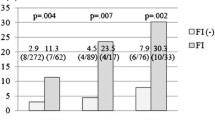Summary
The aim of the study was to compare the mean and maximum flow and the flow pattern of coronary vein grafts (SVG) supplying target vessels of the inferior and lateral wall with internal mammary (IMA) grafts to the left anterior descending artery (LAD). In 21 patients 25 bypass grafts (13/25 SVG, 12/25 IMA) were investigated. Using the transit time ultrasound method, flow was measured every 5 ms and the flow data of 60 s were acquired. The flow pattern showed significant differences between both graft types during their cycle. IMA grafts showed only one peak occurring after 22.1±12.3% and the second after 63.4±15.5% of their cycle. The mean flow was not different in both graft types (IMA: 45.3±27.0 ml/min and SVG: 41.8±26.7 ml/min, p = n. s.) as it was the case for the maximum flow (IMS: 98.4±45.2 ml/min and SVG: 75.7±55.4 ml/min, p = n. s.). In conclusion, there is a different flow pattern for both graft types concerning the number and the occurrence of flow-peaks in the bypass cycle. The mean and peak flow showed no significant difference.
Zusammenfassung
Ziel der Studie war es zu untersuchen, ob typische Flußcharakteristika für A.-mammaria-Bypassgefäße zum Ramus interventricularis (IMA) und venöse Bypassgefäße zu Zielgefäßen der Lateral- und Hinterwand des Herzens bestehen (ACVB). Bei 21 Patienten wurden insgesamt 25 Bypassgefäße untersucht (12/25 IMA, 13/25 ACVB). Mit der Ultraschall-Transit-Zeit-Methode wurden für 60 s Flußdaten mit einer zeitlichen Auflösung von 5 ms akquiriert. Signifikante Unterschiede zeigten sich bei den Flußmustern der beiden Bypasstypen. Die A.-mammaria-Bypassgefäße wiesen nur eine Flußspitze nach im Mittel 45,5±18,6& ihres systolisch-diastolischen Zyklus auf. Bei den venösen Bypassgefäßen traten zwei Flußspitzen auf, eine nach 22,1±12,3% und eine nach 63,4±15,5% des systolisch-diastolischen Zyklus. Der Vergleich der beiden Bypasstypen zeigte keinen Unterschied hinsichtlich des mittleren Flusses (IMA-Bypassgefäße: 41,8±26,7 ml/min vs. ACVB: 45,3±27,0 ml/min, p = n. s.) und des maximalen Fllusses (IMA-Bypassgefäße: 75,7±55,4 ml/min vs. ACVB: 98,4±45,2 ml/min, p = n. s.). A.-mammaria-Bypassgefäße zum RIVA zeigten nur eine Flußspitze nach 45% ihres Zyklus. Venöse Bypassgefäße zu Zielgefäßen der Lateral- und Hinterwand des Herzens hatten zwei Flußspitzen, eine nach 22% und eine nach 63% ihres Zyklus. Der mittlere und maximale Fluß war in beiden Bypasstypen nicht unterschiedlich.
Similar content being viewed by others
Author information
Authors and Affiliations
Additional information
Eingegangen: 16. Juni 1998, Akzeptiert: 23. März 1999
Rights and permissions
About this article
Cite this article
Voigtländer, T., Dahm, M., Kreitner, K.F. et al. Intraoperative Flußmessung koronarer Bypassgefäße mit der Ultraschall-Transit-Zeit-Methode. Z Kardiol 88, 773–779 (1999). https://doi.org/10.1007/s003920050351
Issue Date:
DOI: https://doi.org/10.1007/s003920050351




